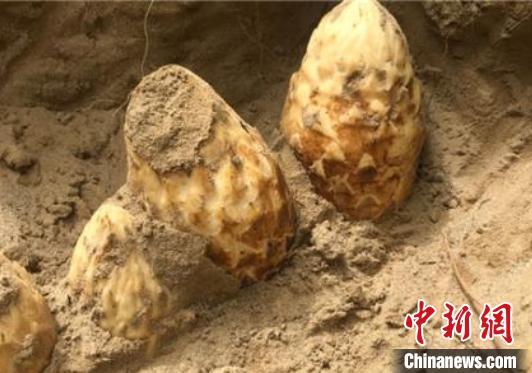NW China's Xinjiang creates economic benefits from its sound ecological environment
In recent years, Hotan prefecture in northwest China's Xinjiang Uygur Autonomous Region, once plagued by desertification, has effectively improved its ecological environment and has created huge economic benefits for local residents.
Villagers in Cele county, Hotan, have planted 8,000 mu (533 hectares) of red willows and haloxylon ammodendron, in order to anchor the sands. Cistanches Herba, a kind of Chinese herbal medicine, has also been planted underneath the shade of these trees to both reduce soil erosion and generate additional economic benefits.

Photo shows Cistanches Herba, a kind of Chinese herbal medicine. The plant has become both a cash cow and a tool to anchor down the sands for villagers in Cele county of Hotan prefecture, northwest China's Xinjiang Uygur Autonomous Region. [Photo/Chinanews.com]
Nurmemet Sidik is a farmer from Cele. Last year, his family earned 200,000 yuan ($30,801) by planting Cistanches Herba. "With the money, I decorated my house and bought a new car. Our life is getting so much better," said the man.
Sidik also expressed that he is excited that a Cistanches Herba processing plant is now under construction near his home, because after it is put into operation, he could earn more by directly selling it the herbal medicine.
"At present, nearly 42,000 mu of Cistanches Herba has been planted in our county, generating an annual output value of more than 50 million yuan. Villagers' incomes have been continuously increasing alongside the ecological improvements," said Turghun Jappar, an official from Cele county’s forestry and grassland bureau.
Cele is the epitome of Hotan's endeavors to promote ecological protection and economic growth. Between 2016 and 2020, Hotan has made every effort to prevent and control desertification, with a total of 3.58 million mu of sandy areas now under control. During this period, Hotan has afforested more than 450,000 mu of land. The total area of natural forestland has increased from 4.6 million mu to 4.8 million mu.
Since 2016, Hotan has seen an 8 percent increase in the volume of precipitation and a 54 percent drop in the occurrence of sandstorms, both attributable to the fact that governments at all levels in the prefecture have attached a high degree of importance to the ecological environment, tree planting, and the afforestation of marginal farmland, said Song Jingdong, a senior engineer with the meteorological bureau in Hotan.
























